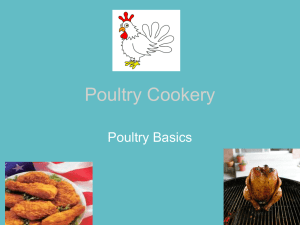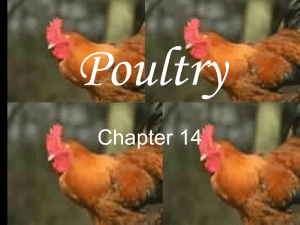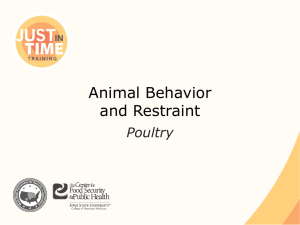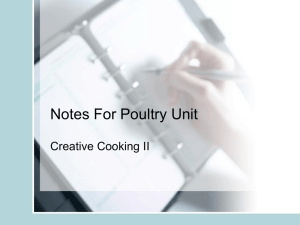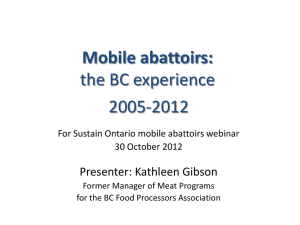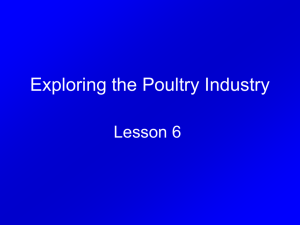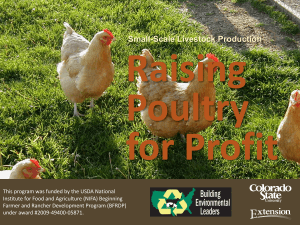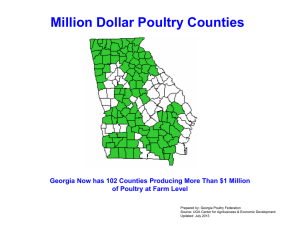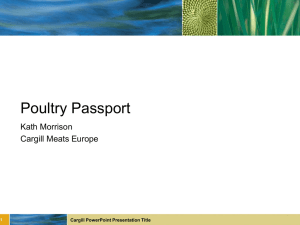On-Farm Direct Sale Exemption
advertisement
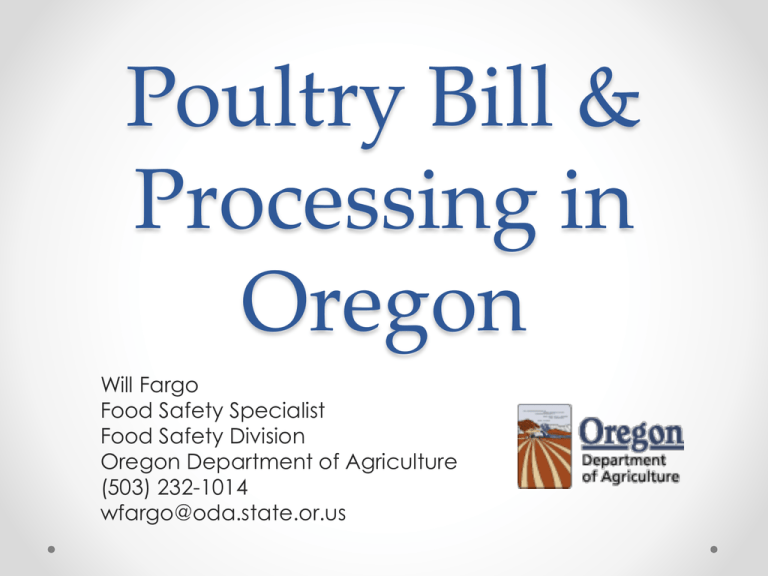
Poultry Bill & Processing in Oregon Will Fargo Food Safety Specialist Food Safety Division Oregon Department of Agriculture (503) 232-1014 wfargo@oda.state.or.us Jurisdiction & Regulatory Authority Local Authorities Food Safety Inspection Service • 1957: Poultry Products Inspection Act (PPIA) mandated Federal inspection at businesses that slaughter poultry or process poultry products that enter interstate or foreign commerce. • 1968: Extended the mandate for Federal inspection to all businesses that slaughter or process poultry for shipment within a State unless the firm meets certain exemption requirements within the act. USDA Food Safety Inspection Service Exemptions Personal Use Custom Processing Poultry Producer/Grower – 1,000 bird limit Poultry Producer/Grower – 20,000 bird limit Poultry Producer/Grower or Other Person (PGOP) • Small Enterprise – 20,000 bird limit • Retail Sales • • • • • Food Safety Division Food Safety Division Agriculture Development Animal Health Commodity Inspection Food Safety Measurements & Standards Natural Resources Pesticides Plants Food Safety Division • Oregon Revised Statutes (ORS) 603.025 & 616.706 require licensing of poultry processing facilities. • ORS 619.026: Sanitation requirements. • Oregon Administrative Rules (OAR) 603-028 & 603025: Building & Facilities requirements Oregon House Bill 2872 • Signed by the Governor May 19, 2011, effective immediately. • Creates an exemption from ODA licensing requirements for a person who raises and slaughters no more than 1,000 poultry per year and meets other conditions. What species of poultry can be processed under the Poultry Bill? Domesticated species including chickens, turkeys, ducks, geese, or guinea fowl. Poultry does NOT include ratites, endangered or protected species, wild game birds, non-game wild birds, or pet birds. Why wouldn’t this qualify? How many poultry can be processed under the Poultry Bill? No more than 1,000 poultry per year of all species combined. Can I purchase live poultry to process under the Poultry Bill? No, the person performing the slaughter must raise the poultry since they are two weeks of age or younger. Poultry must be wholesome, unadulterated and free from disease Do I have to keep records? • Yes, the person claiming the exemption must maintain clear and understandable records documenting the following: o The person raised the poultry since it was two weeks of age or younger. o The year-to-date cumulative total of each species and total quantity of poultry slaughtered. o Date of Slaughter. o Sales records (species, quantity and date of sale). o Address of the poultry business. o Sanitation Logs documenting slaughter, cleaning, warewashing, chemical use and any other records required by the ODA. • Records must be made available to ODA inspectors on request. Things you cannot do under the Poultry Bill • Poultry cannot be sold to restaurants, hotels, institutions or grocery stores. All sales must be directly to the end consumer. • Poultry cannot be cut up, ground or further processed and must be sold as a whole carcass. • Poultry may not enter interstate commerce. This includes selling poultry to residents of another state who intend to return to their state with poultry processed under the Poultry Bill. Are there any labeling requirements? The label must include: • Net weight • Product description (including species and type of cut) • Farm name • Farm address (or zip code only if your farm is listed in a local directory) • Safe handling instructions (next slide) • “THIS PRODUCT MAY NOT LEAVE THE STATE OF OREGON” in type that is at least ¼-inch tall. Can I freeze poultry after slaughter, to hold for a customer? Yes Are exempt firms inspected by the ODA • Firms processing under the Poultry Bill are not placed on a routine inspection schedule by the ODA. • The ODA may conduct an unscheduled inspection of an exempt poultry slaughtering facility and its records. • Failure to conduct activities in accordance with the Poultry Bill will make a person or poultry business subject to the licensing provisions of ORS 603.025 and 616.706 and all applicable regulations and penalties. Am I required to construct a poultry processing building? • Because The Poultry Bill exempts firms from licensing requirements (ORS 603.025 & 616.706) but does not exempt firms from building, facilities or sanitation requirements (ORS 619.026, OAR 603-025 & OAR 603-028). • It is the intent of the Department’s Food Safety Division to promote and enable the State Legislature’s directive to encourage Oregon-grown poultry production for consumption in the state of Oregon by Oregonians. • The Oregon Administrative Rules distinguish between two different types of exemption under the Poultry Bill, the Off-Farm Direct Sale Exemption and On-Farm Direct Sale Exemption. Off-Farm Direct Sale Exemption • This exemption allows an individual to sell poultry away from the farm directly to the end consumer (i.e. farmers market sales). • In order to qualify under the Off-Farm Direct Sale Exemption, an individual must provide a poultry processing building in compliance with ODA poultry processing buildings and facilities requirements (ORS 619.026 and OAR 603-028-0100). On-Farm Direct Sale Exemption • This exemption restricts an individual to on-farm sales only, meaning direct sales to the end consumer who comes to the processing location to purchase poultry. • Under the On-Farm Direct Sale Exemption, poultry processing can be conducted with minimal building and facilities and a poultry processing building is not required. Poultry must be “reasonably” protected, which can be accomplished with a combination of a canopy, tarps, and floor mats. • Limiting sales of poultry processed under minimal building and facilities gives consumers some capacity to assess sanitation, building and facilities themselves when they purchase poultry. Give a Hoot, Don’t Pollute • A producer may compost up to 20-ton (40,000 pounds) of solid and liquid waste (blood, offal, feathers) without a permit from any agency of the State of Oregon. Composting must not influence surface water. • A producer who composts greater than the 20-ton limit or who wants to apply solid and/or liquid waste (blood, offal, feathers) directly to the surface of the land can contact the ODA's Natural Resources Division at 503-986-4700 for further information and permit requirements that may apply to their specific situation. ODA CAFO Program ODA Ag Water Quality Program • Addresses water pollution associated with agricultural lands and activities. • Clean Water Act o Regulates discharge into public waters o NPDES Permitting • Oregon Agricultural Water Quality Act o Soil & Water Conservation Districts • Coordinated Water Management o Mechanism to respond to water quality issues o 39 plans and rules Other ODA Programs • • • • • • Pesticide Program Fertilizer Program Commodity Inspection Animal Health & ID Plant industry Agriculture Development & Marketing Resources Lauren Gwin, Ph.D. Research Associate Darren Sisk, Investigator Agricultural and Resource Economics Department USDA, FSIS, OPEER, CID Oregon State University (503) 399-5643 (office) (541) 737 1569 (office) (503) 399-5644 (fax) Western Region (541) 760 0529 (cell) Will Fargo Food Safety Specialist Food Safety Division Oregon Department of Agriculture wfargo@oda.state.or.us (503)232-1014 (office) (503) 432-7092 (cell) OSU Guide: Best Practices for Open Air Slaughter • • • • • • • Processing site • Water • Personal hygiene Equipment • Pathogen Control Anti-microbial spray step • Packaging Monitoring & Recordkeeping Wastewater & offal disposal Zoning Useful Resources Download from OSU Small Farms website: http://smallfarms.oregonstate.edu/oregon-smallfarms-technical-reports
